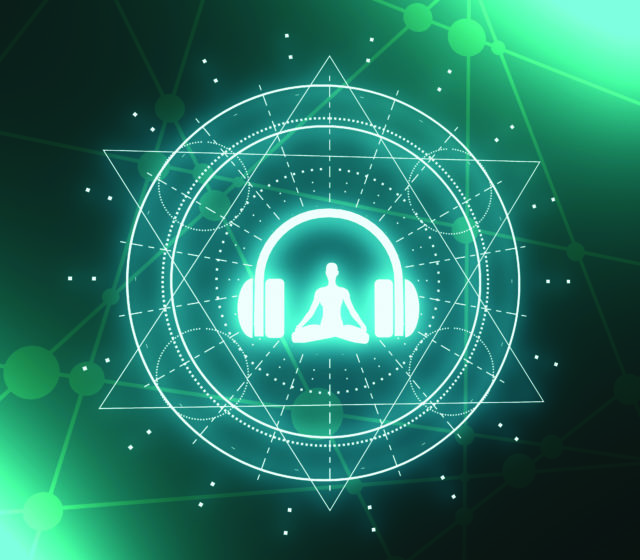
In September 2020, Chuck Hyde decided to turn his 15 years of experience as a massage therapist doing body and nervous system work into a new establishment: Light Club, a North Boulder studio that combines acoustic, visual and physical therapies for a full-sensory immersion that claims to cultivate deep relaxation. Although it could be considered “woo-woo” by some, there is a good deal of science and technology behind Hyde’s operation.
Marketed as a “non-medical treatment” for stress, anxiety, depression and myriad other ailments, Light Club created a comfortable and sober environment in which to be still. Though Hyde admits he is not anti-drug, he does understand that “non-substance experiences” are able to reach a broader audience as they are generally considered less intimidating. During the 55-minute relaxation sessions, clients enjoy tactile comforts like heated vibration-therapy tables and weighted blankets in addition to the soothing acoustic and visual elements.
“The whole experience [style] just landed for me,” Hyde says. “[It] made me feel lighter, like I was wearing an anti-gravity suit, both physically and spiritually. The more I did it, the more perceptual shifts I experienced; I basically thought, if it affects me in this way, then it has the potential to help other people too.”
Acoustic resonance therapy, also known as vibrational sound therapy, has been used in therapeutics for years. Light Club, however, has a slightly different approach, employing the use of a locally made patented system called the Sound Heart.
“The Sound Heart is unique in its ability to express vibration with low levels of distortion with harmonic intelligence,” Hyde explains, “which resonates into the water matrix, connective tissue and bone matrix of the body. When these vibrations are registered in the nervous system, they bypass pain structures and work through stress perceptions; they open the capillary beds and integrate the central nervous system.”
A body of research published in the last 20 years proves Hyde’s claims: the vibrational quality of sound can affect the human body on a cellular level. The National Center for Biotechnology Information published an article that states: “The most basic and oldest use of vibratory effect is the mechanical ‘shaking’ of the body and more recently specific areas and cells. Another more specific category of cellular response is the effect of driving a neural modulatory response.”
My session with Hyde begins with a brief tour of Light Club; the room is full of second-hand trinkets, none of which seem to have lost their magic. Lingering smells of incense and dimmed lights are enough to encourage relaxation, and mirrors of different sizes and shapes line the walls, reflecting back a large table centered in the room, around which four vibration tables are prepared with blankets and headphones. Hovering over the tables are a series of lights, from which various bells dangle. Crystals sit on tables overflowing with piles of burned incense and an abundance of drums, trinkets and more mirrors. Hyde explains that when negative energies leave the body, they have to go somewhere, and mirrors are excellent gateways for this purpose.
An enormous pair of water buffalo tusks occupy the central table, intricately carved and, according to Hyde, bought at a garage sale for $50; they’re wrapped in strings of beads and mala strands with colored tassels.
I lay down on the table, which is padded, and place my head on a small pillow, my knees over a soft bolster. Weighted blankets cover me from toes to neck as I place the headphones over my ears. I am immediately cut off from the room and dipped into an ambient-sound state. Hyde speaks to me through the headphones, though his voice is soft and sounds far away. He instructs me on some meditative techniques I can employ in the session, and then he slips away and I’m fully immersed; though it takes a few minutes for my eyes to adjust to the light, I’m quickly able to relax and fully sink myself into the physical, auditory and visual flow of the experience.
For visual stimulation, Light Club uses the Lucia No. 3, a combined analog and digital light hand-built in small batches in Austria. Developed by neurologists, this particular light uses both LED and halogen bulbs, and in research, the Lucia No. 3 was found to turn on similar parts of the brain as strong psilocybin mushrooms—parts of the brain that promote relaxation and stillness. Though the light was originally created as a therapeutic tool for people who’d had near death experiences, it is now patented and built specifically for use in healing and relaxation practices.
As in many meditative practices, it was easy for my mind to wander, worrying about deadlines and thinking about what I would eat for dinner when I got home. As Hyde suggested, I was usually able to move back into a calm state by focusing on my breath. He also emphasized the fact that not everyone would get the same levels of deep relaxation from the experience; people who have maintained embodiment practices, such as yoga, or meditative practices, are more likely to have deeper sessions faster.
As a yogi and part-time meditation practitioner, I was able to navigate my way through the ebb and flow of unwanted, distracting thoughts to find prolonged periods of deep relaxation and peace that were similar to experiences I’ve had in mantra meditation. What made this experience unique was the full-sensory immersion and Hyde’s attention to non-medicinal pathways to stillness, safety and tranquility. “Pharmaceuticals are over-sold,” says Hyde. “People forget that we produce our own chemicals; we’re capable of hacking our own nervous systems by adjusting our exposure to different stimulus; it lubricates our ability to move through states of embodiment, and states of being, and it’s really quite beautiful if you give yourself over to it.”














